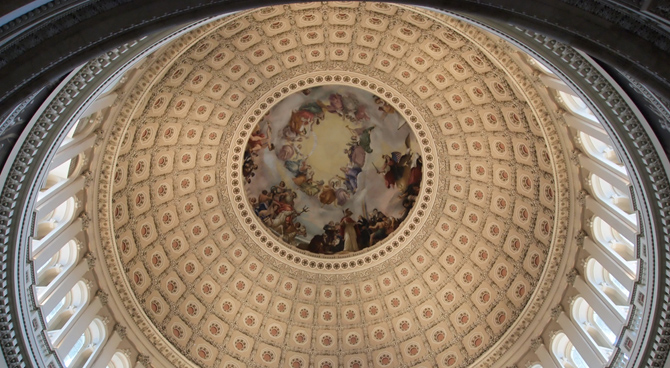Federal budget deficits are back with a vengeance. With the U.S. economy showing clear signs of recovery, it is time for Washington policymakers to shelve budget-busting health care reform and “cap-and-trade” legislation and focus instead on reducing deficit spending.
Newly released budget projections from the Congressional Budget Office (CBO) and the Obama administration paint an alarming fiscal picture: The CBO says the deficit will be $1.6 trillion by the end of this year and $1.4 trillion in 2010, or $3 trillion in new borrowing in two years.
By contrast, in the 219 years from 1789 to 2008, America amassed $5.8 trillion in federal debt. The president’s Office of Management and Budget (OMB) predicts government debt rising to $5.3 trillion by the end of 2019. According to OMB, the president’s budget plan will produce deficits totaling more than $9 trillion over the next decade, while CBO projects deficits closer to $12 trillion over the same period.
Either way, trillion-dollar deficits as far as the eye can see is the projected result of President Obama’s budget plan, with federal budget deficits and debt rising to levels not seen since World War II.
At these eye-popping levels, budget deficits do matter. Higher deficits, all other things being equal, put upward pressure on interest rates. Interest payments will triple as a share of the economy and more than quadruple in dollar terms over the next decade from $172 billion next year to $806 billion in 2019, which would be about $200 billion more than we spend each on Social Security and the Pentagon budget.
And those record-high deficits and interest payments are based on highly doubtful economic assumptions. Mr. Obama’s budget assumes his deficits, which will average the largest share of the economy as measured by decade, by administration or by post-recession recovery, will somehow permit extremely low Treasury interest rates and near-record rates of economic growth.
If this rosiest of scenarios does not happen, the federal debt will spiral further out of control. At some point, the Federal Reserve Board will have to monetize the debt, which in turn will produce higher inflation.
It’s time to bring back and update the Gramm-Rudman-Hollings emergency deficit-cutting law. Championed by former Sens. Phil Gramm, Texas Republican, Warren Rudman, New Hampshire Republican, and Ernest Frederick “Fritz” Hollings, South Carolina Democrat, the bipartisan Gramm-Rudman law was enacted in 1985, when Congress was under intense public pressure to reduce what was then considered an unheard-of budget deficit of $200 billion.
Specifically, the law required Congress to meet year-by-year deficit-reduction targets, ending with a balanced budget by the end of 1991. If Congress missed those targets, the law triggered automatic across-the-board spending cuts – a process called “sequestration” – to reduce deficit spending to the mandated level.
Critics charged that Gramm-Rudman failed because Congress routinely missed the annual deficit-cutting targets by an average of $30 billion, and the budget was never balanced while the law was in effect. True, but all told, Gramm-Rudman did produce lower deficits: The fiscal 1989 deficit was about $100 billion lower than had been expected in 1985 without Gramm-Rudman, and deficits as a share of our national economy decreased from 5.8 percent to 3.8 percent from 1985 to 1989. Gramm-Rudman also curbed the growth of government spending from an annual average of 8.7 percent in the five years before the law to 3.2 percent in the five years it was in effect. Even entitlement-spending growth slowed to 5 percent annually as Congress trimmed mandatory spending to avoid draconian cuts in discretionary spending programs.
Gramm-Rudman was like President Truman’s “containment policy” – it did not eliminate the budget deficit, but it stopped the deficit’s growth when it appeared to be unstoppable.
The 1990 Budget Enforcement Act effectively replaced the Gramm-Rudman deficit-reduction targets with two enforcement regimens: caps on discretionary spending and a pay-as-you-go requirement for direct spending and revenue legislation. Interestingly, the deficit limits and across-the-board sequester mechanism were suspended in 1990 but could have been re-triggered by the president on Jan. 21, 1993. Although President Clinton decided not to re-trigger Gramm-Rudman, there are remnants of the law that could be restored and updated by congressional action today.
A new Gramm-Rudman emergency deficit-control act should set annual deficit-reduction targets beginning in 2010 and ending with a balanced budget by 2016. We suggest a couple of improvements: One, instead of annual dollar-amount deficit targets, the new Gramm-Rudman should have percentage of gross domestic product (GDP) deficit targets, starting at 10 percent of GDP in fiscal 2010 and declining in proportionate steps all the way down to zero in 2016. For instance, the president’s budget would have to chop out deficit spending amounting to 2.9 percent of GDP to comply with the mandated deficit target in 2010.
By setting annual deficit ceilings as a share of the economy, Congress would have more incentive to adopt pro-growth economic policies and avoid anti-growth policies such as increasing tax rates on work effort and investment or raising taxes on energy.
Second, an updated Gramm-Rudman should include all government expenditures in the across-the-board sequester except for interest payments and Social Security benefits. To avoid cheating and gaming, there also should be a second, “look-back” sequester to prevent Congress from back-loading spending programs to avoid the initial sequester, as it did in the late 1980s.
For national and homeland-security spending, the original Gramm-Rudman allowed the president to protect specific defense programs from the sequester; the new act would retain this flexibility for both defense and homeland security spending. The threat of triggering deep and painful automatic spending cuts would impose a much-needed dose of fiscal discipline on Congress and force Democrats and Republicans to agree on a deficit-cutting plan every year.
Balancing the budget by 2016 is admittedly tough – some will say impossible. But it can be achieved through the combination of firm spending restraint and, most important, rapid economic growth.
Remember, in the late 1990s, the Republican Congress and Mr. Clinton cut spending and reduced the capital-gains tax, which rapidly produced huge budget surpluses: From 1997 to 2000, the federal balance sheet went from a $21 billion deficit to a $236 billion surplus.
So balancing the budget in six years is achievable, but members of Congress will need the threat of automatic spending cuts to force them to get the job done.
Cesar V. Conda is a former economic and domestic policy adviser to former Vice President Dick Cheney, and Michael J. Solon is a former economic adviser to former Sen. Phil Gramm.





